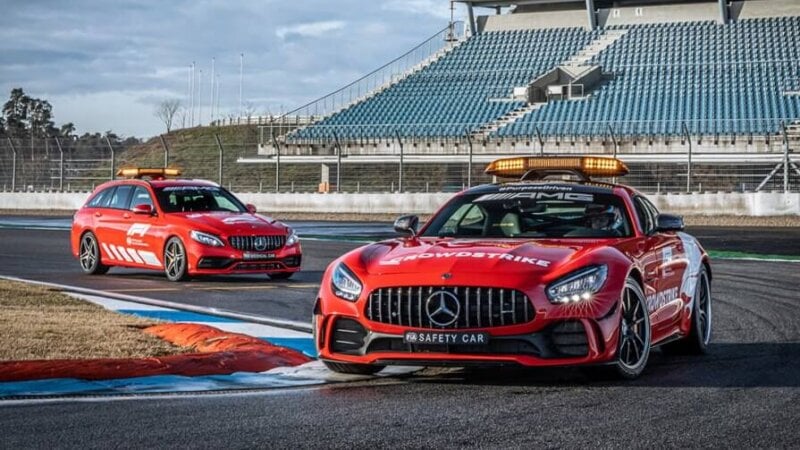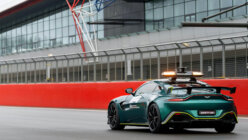Aston Martin will mark its return to F1 this year after a 60-year absence by also becoming an official supplier of F1’s safety and medical cars.
It’ll be the first time in 26 years that something other than a Mercedes-Benz will take up either role, and the first time in the sport’s history that an Aston Martin will do the job. To fill the brief, Aston will supply two different models from its range, with the Vantage performing safety car duties and the brand’s first SUV, the DBX, as the medical car.
F1 cars are highly sensitive to temperature, and that means that the F1 safety car has to be a pretty rapid machine in its own right. If the racing pack behind goes too slow, they lose temperature in their tires and brakes, and can cause further incidents when back up to racing speeds. They’re also not too fond of dawdling around corners, as they need high-speed airflow over the wings to generate downforce. Luckily, the Vantage has that covered already, but Aston Martin has fettled it for the challenge too.
Naturally, Aston has turned the wick up a little on the Mercedes V8, and the Vantage Safety Car now produces 528hp. The torque peak sits at the same 505lbft, but it’s wider peak allowing for longer torque delivery, and the eight-speed gearbox has also been overhauled for sustained track duty.
In addition there’s more underbody bracing to increase stiffness, and redeveloped suspension and steering. Aston Martin has focused on cooling, as the safety car’s duty cycle means there’s no chance for a cool-down lap, so there’s more venting in the hood and extra brake ducts.
Of course high cornering speeds are a major requirement for an F1 safety car, and Aston has added a new front splitter which works with that enormous rear wing to produce more than 2.5 times the downforce of the road car: 350lb (155kg) at 124mph (200km/h), compared to just 135lb (60kg).
The DBX is perfectly suited to the medical car role too. Like the Vantage, this boasts a twin-turbo V8, but it’s producing 542hp and 516lbft, but it’s more about how quickly it can get vital life-saving gear to the scene of an accident than keeping up race pace. With four seats — the central rear seat is deleted for the role — the DBX can carry F1’s medical chief Dr. Ian Roberts and a backup medic, in addition to leaving a seat spare for a walking wounded driver for evacuation to the track’s medical facilities.
With 632 litres of boot space, the DBX is able to haul all of the medical equipment needed to treat injuries on scene. There’s also a defibrillator and two fire exinguishers on board.
Both the DBX and Vantage feature the same Aston Martin Racing Green paintwork as the AMR21 race car, although with lime green accents rather than the pink of the race car’s sponsor BWT. Each is equipped with a light bar and marker LEDs, and has FIA-approved seats with six-point racing harnesses throughout.

However, Mercedes is not out of the picture entirely, as the two brands will split safety car and medical car duties this season. Each brand is scheduled to appear at roughly half the races, with Aston Martin taking both the pre-season test and first race of the 2021 season in Bahrain, and Mercedes taking over for the race at Imola.
The Mercedes cars boast a new look too, with the AMG GT R safety car and the AMG C63 S Estate now sporting a red paint job. Whether the race uses Mercedes or Aston Martin equipment, the drivers will remain as Bernd Maylander in the safety car and Alan van der Merwe in the medical car.
See more articles on 2021 Formula One World Championship and Aston Martin.





